|
|
| Photo Gallery |
|
| Video Gallery |
|
|
 |
|
 |
|
|
|
|
About Warangal |
|
The tri-cities of Warangal, Hanamkonda, Kazipet, together known as Warangal is the fourth largest city in Andhra Pradesh and the 32nd biggest city in India, with a population is 928,570. It is the second largest city in Telangana. It enjoys the unique distinction of being the capital of great family of rulers, known as the Kakatiyas, who estabilshed their sovereignty over vast areas of the Telugu speaking country between 1150 AD and 1323 AD. The benevolent Kakatiya rulers brought political stability, economic prosperity, linguistic and cultural unity, artistic splendour and literary efflorescence to the kingdom they built. The distinct term "Kakatiya" strikes an emotional chord in the hearts of the Telugu people. The artistic beauty of the temples with excellent sculpture of unique style, ever green wild life sanctuaries, and the glittering tanks with ripples are a feast to see to the eye. The amazing Thousand Pillar Temple, the Bhadrakali and the Padmakshi temples, the Warangal Fort, the dense forests of Eturunagaram and Pakhal, Laknavarm Lake and other destinations are the important tourist spots in and around Warangal.
"Historic", "pristine", and "value-oriented" are just a few terms associated with Warangal, and one has to be present here to truly experience the exotic atmosphere of this historic city. Turbulent yet modest, polite but dissenting, defiant yet sacrificing, vibrant and alluring, Warangal has a mystic charm attached to its culture. The city is a shining example of valued traditions. It is now globally famous as Cultural Heritage City and bagged the Award of Clean and Neat City. To the modern tourist, Warangal offers peerless excitement and excellent entertainment that includes Heritage, Nature, Wildlife, Cultural and Shopping sites and malls, making it one of the most memorable tourist destinations in South India.
The Warangal District has great intellectual legacy. The Kakatiya period was rightly called the brightest period of the Telugu history. The entire Telugu speaking area was under the kings who spoke Telugu and encouraged Telugu. Bammera Pothana, Palkurki Somanatha, Sivadevayya, Andhra Bhoja, Iswara Bhatta, Nrisimhakavi, Agasthya, Madhava Vidyaranya, Gangadevi and others adorned the Kakatiya Era and some of them formed the brain behind the foundation of the Vijayanagara Empire. In modern times, "Prajakavi" Padmabhushan Kaloji and Dr K. Jayashankar, the ideologue of Telangana, are remembered with reverence.
|
| |
| The Warangal Fort |
|
It is one of the most famous Medieval Forts of Deccan. It was extended and improved during the rein of Ganapati Deva and Queen Rudramamba (1262-89 AD). The circular stone fortrication was surrounded by an outer mud fort with four main gates. A moat had also been dug all around the Fort to render the city impregnable. Swayambhu Temple dedicated to Lord Shiva occupies the central part and it was marked by four ornake toranas renowned as the "Hamsatoranas" comparable to Sanchi Stupas. The ruins strewn all over, however, bear eloquent testimony to their original beauty and sculptural grandeur. They are under the process of bringing back the past glory.
|
 |
| The Thousand-Pillar Temple |
|
It is one of the most famous Medieval Forts of Deccan. It was extended and improved during the rein of Ganapati Deva and Queen Rudramamba (1262-89 AD). The circular stone fortrication was surrounded by an outer mud fort with four main gates. A moat had also been dug all around the Fort to render the city impregnable. Swayambhu Temple dedicated to Lord Shiva occupies the central part and it was marked by four ornake toranas renowned as the "Hamsatoranas" comparable to Sanchi Stupas. The ruins strewn all over, however, bear eloquent testimony to their original beauty and sculptural grandeur. They are under the process of bringing back the past glory.
|
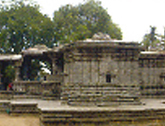 |
| The Bhadrakali Temple |
|
Situated atop a hillock between Hanamkonda and Warangal, it is one of the oldest Devi temples in this part. It is famous for the stone image of Goddess Bhadrakali. Eight-armed, with a weapon in each hand, she is shown in an eye-catching posture, bestowing her benevolent blessings on all the devotees. Built in the days of the Chalukyas, the temple is situated on the bund of a big Bhadri Tank, panoramic amidst the bare boulders atop the hill and the silent waters below.
The temple is believed to be built by the King Pulakesi II of Chalukya dynasty around 625 A.D to commemorate his victory over Vengi region of Andhra Desham. This can be observed from the square pillars used in the temple structure which were different from the circular pillars commonly used in temples constructed by Kakatiyas who adopted Goddess Bhadrakali as their "Kula Devatha" giving preference to Her to other Gods and Goddesses. The lake was built later by Ganapathi Deva, a minister in Kakatiya Dynasty. A road leading to the temple was also added during that period.
Before the temple was renovated in 1950 there were animal sacrifices at the temple (an old custom practiced at Kali temples in India). This practice was banned from 1950 onwards after the renovation of the temple. During the renovation, Chandi Yantra was installed in the temple and Amrutha Beejaksharas (holy shlokas) were written on the deity's hanging tongue and modified the deity's fierce looking eyes and tongue to a benevolent face made in a 2.7x2.7 meters square stone facing West with Shiva under her feet. 'Sree Chakram' and 'Utsava Vigrahas' of Bhadrakali are placed in front of the main deity. Since then everyday poojas, Sharannavaratras, Vasantha navarathras are being conducted regularly as per the Vedic rites.
|
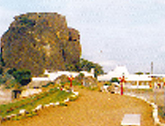 |
A statue of Lion, Bhadrakali's Vahana, on which she rides, is placed opposite the sanctum sanctorum. The temple also has a Dhwaja Sthambam and Balipeetham. Some of the oldest deities in the Maha Mantapam along with Bhadrakali are Uma Maheshwara images on stone in front of Shiva Linga, Subramanya Swamy statue, Hanuman statue and Navagrahas all carved in stone.
The temple has been expanded in the 2000s with the addition of Alaya Shikaram and Maha Mantapam. Recently Sri Vallabha Ganapathi temple and temple parikrama have been added to the main temple. The temple management is also running a Veda Pathasala (School for Learning Vedas) near the temple.
There are 8 major and 12 minor temples in the mountains surrounding the Bhadrakali Temple including Padmakshi Temple, Sri Shirdi Sai Baba, Sri Narasimha Swamy Temple and Sri Pothuluri Veerabrahmendra Swamy Temple, the Nostradamus of India.
Here is the list of Alankarams of Goddess during Sharan Navarathri:
- Day 1 - Ashwayuja Padyami - Sri Swarna Kavachalankruta Durga Devi
- Day 2 - Ashwayuja Vidiya - Sri Bala Tripura Sundari Devi
- Day 3 - Ashwayuja Thadiya - Sri Gayatri Devi
- Day 4 - Ashwayuja Chavithi - Sri Annapurna Devi
- Day 5 - Ashwayuja Panchami - Lalitha Panchami - Sri Lalitha Tripura Sundari Devi
- Day 6 - Ashwayuja Shashti - Maha Shashti - Sri Maha Lakshmi Devi
- Day 7 - Ashwayuja Saptami - Maha Saptami - Sri Maha Saraswati Devi
- Day 8 - Ashwayuja Ashtami - Durga Ashtami - Sri Durga Devi
- Day 9 - Ashwayuja Navami - Maha Navami - Sri Mahishasura Mardhini Devi
- Day 10 - Ashwayuja Dashami - Vijaya Dashami - Dasara - Sri Rajarajeshwari Devi
On Vijaya Dashami, the Navaratri celebrations are concluded with colourful Teppotsavam.
|
|
| Batukamma Festival |
|
The Festival is the biggest one in Telangana region for Hindu women who are dressed up in rich traditional pattu saris, and costly jewellery during celebrations. It is followed by Boddemma, which is a 7-day festival. This festival falls in September - October called Ashvin or Aswiyuja. Bathukamma is celebrated for nine days during Durga Navratri. It starts on the day of Mahalaya Amavasya. It concludes two days before Dussera, called Durgashtami. On the final day, the closing ceremony is celebrated on a grand scale as Pedda Bathukamma or Saddula Bathukamma. Bathukamma is a beautiful flower stack, arranged with seasonal flowers, in seven concentric layers, of potter's clay like a cone. Bathuku in Telugu means live / life, and Amma means mother; hence Bathukamma, is celebrated for the glory of Life - Goddess, later denoted as Goddess Maha Gauri - the patron Goddess of Womanhood.
|
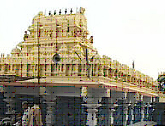 |
| The Ramappa Temple |
|
The great temple of Palampet dedicated to Rudreswara in 1223 AD is said to be a happy synthesis of the best in Western Chalukyan, North Indian Hoysala and Dravidian styles of architecture. The famous Nagini is one of the twelve figures brackets with their haunting melodies. The Nandi mounted on a raised pedestal in the mantapa is unique in its exquisite polish that feels like velvet. The gopura of this temple is built with unique bricks which float on water. Ramappa Lake, just one km away from the temple, is an ideal place for picnics and photography.
|
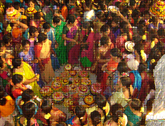 |
| The Laknavaram Lake |
|
One need no longer travel all the way to Rishikesh for the Lakshman Jhoola experience or the Golden Bridge in San Francisco, USA. Our very own Laknavaram in Warangal now has a spring suspension bridge where one can live the experience! The 160-metre-long suspension bridge is the first ever suspension bridge to be built in the state. Built on the hill-hemmed and scenic Laknavaram Lake, 70 kms from Warangal city, the bridge connects two of the seven tiny lake islands. This is the only second suspension bridge in South India. |
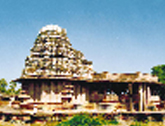 |
|
| |
|
| |
|









